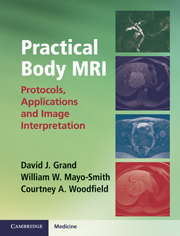Book contents
Chapter 14 - MRA introduction
from Section 4 - MRI angiography
Published online by Cambridge University Press: 05 November 2012
Summary
Since the dawn of radiology, mankind has struggled to image the vasculature and conventional, or catheter-based, angiography has been the gold standard. Advantages of catheter-based angiography include: very high spatial resolution, temporal resolution (allowing the operator to follow the bolus of injected contrast from the artery through the vein), and the opportunity to intervene and treat a vascular abnormality. Many advances have been made in therapeutic interventional techniques particularly angioplasty, stenting, and embolization. However catheter angiography has several disadvantages including expense, imaging time, radiation exposure, and complications. Complications can be severe including hemorrhage, dissection, pseudoaneurysm, and inadvertent vascular occlusion.
Rapid advances in MRI, CT and ultrasound have led to the increasing use of these modalities to diagnose vascular abnormalities. The advantages of these modalities exactly address the disadvantages of catheter angiography including: decreased expense, imaging time, and, in the case of MRI and ultrasound, no ionizing radiation. Cross-sectional imaging has largely replaced catheter angiography for the diagnosis of vascular abnormalities. Catheter-based angiography is now used primarily for therapeutic interventions.
- Type
- Chapter
- Information
- Practical Body MRIProtocols, Applications and Image Interpretation, pp. 139 - 142Publisher: Cambridge University PressPrint publication year: 2012



